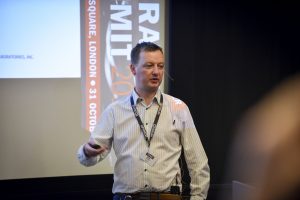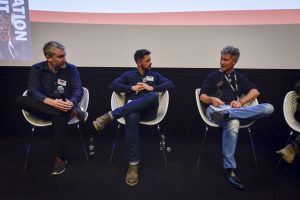Next Generation Audio Summit: Sessions track growing deployment and diversity of immersive audio services

Audio engineer, consultant and educator Felix Krückels gives the Keynote address at the Next Generation Audio Summit 2018. (Image:
©ChrisTaylorPhotography.com)
‘From theory to reality’ was the subtitle of the Next Generation Audio Summit 2018, and appropriately so since the last 12 months have witnessed a myriad of real-world NGA deployments for sports and entertainment. Taking place at Dolby’s facilities in Soho Square, London, on 31 October, the summit provided an opportunity to take stock of immersive audio’s recent progress – and also ponder some of the obstacles that still remain to broader global adoption.
Following introductory remarks from SVG Europe contributing editor David Davies and Dolby senior product marketing manager Rob France, Felix Krückels provided an elegant summary of NGA’s potential for sports broadcast in his opening Keynote, entitled Immersive for Sports and the Future of Broadcast Audio Mixing. A familiar name throughout the industry due to his long association with Lawo, Krückels remains an in-demand broadcast audio mixer and has recently taken up the role of professor for broadcast production and system design at the Mediacampus of the University of Applied Sciences Darmstadt/Dieburg, Germany.
Drawing a parallel with the heightened spatialisation achieved by modernist painters such as Picasso, Krückels described the move towards immersive audio for broadcast as “a logical next step; after all, we perceive audio in three dimensions. The question has always been: how can we get this third dimension [into broadcast]?”
Krückels proceeded to outline the key aspects of work carried out before a recent international football tournament, for which all matches were delivered with a Dolby Atmos production. Krückels served as a live sound mixer throughout the tournament. A complex audio design featured more than 50 microphones, with a guiding principle regarding audio capture at matches playing a critical role in determining the final deployment: “[The federation involved] won’t allow moving microphones, [so that rules out] boom operators, especially if they are able to climb in the direction of the coaches and any discussions they may be having with the players” – not least because of the offensive language that may be picked up.
Working in close conjunction with Helmut Wittek from Schoeps, it became clear that “we could achieve the coverage we wanted to without having moving mics”. It was Wittek who proposed the idea of using a M/S mic to derive three discrete angles at each position, making it possible to capture sound more effectively from +-45 degrees, thereby simulating moving microphones such as those that might be found at a central camera position.
With so many microphone feeds in the frame, the audio team needed to be able to rely on a certain degree of automation, and in this regard the Lawo KICK system was highly beneficial. Interfaced to image analysis and tracking systems, KICK is designed to ensure a consistent, fully-automated, high-quality, close-ball audio mix. Waves’ transient designer software was another pivotal tool, making it feasible to “achieve a cleaner sound that is closer to the action, deeper into the pitch.”
For this tournament the audio team created a number of presentations, including a non-broadcast mix, a stereo mix, a 5.1 mix and a broadcast mix in 9.1 with commentary. The principal difference between the 5.1 and the 9.1 is “to have the PA at the same level you would perceive it if you were inside the venue,” said Krückels.
Feedback to the audio presentations was “very good” and in line with the team’s stated objectives of achieving both “quality and consistency”. But inevitably, further refinements have suggested themselves, including the possibility of delivering dedicated presentations geared towards the supporters of different teams.
Listening to Krückels’ presentation, there is no doubting his enthusiasm for the possibilities of immersive and object-based audio. But with the likelihood that one audio mixer will continue to be fundamentally responsible for all the different presentations, “the greatest challenge in live object-based audio will be to effectively monitor and supervise all these different feeds”.
The trouble with terminology

Dolby’s Rob France outlines some of the features of the new Dolby AC-4 format. (Image: ©ChrisTaylorPhotography.com)
Following the Sky Sports Immersive Audio Panel (which will be the subject of a separate report to be published soon on the SVG Europe website) and a networking break, Rob France took to the stage to offer a progress report on Dolby Atmos, including details of the new AC-4 format.
But France began by hinting that one of the main factors currently holding NGA back could well be the preponderance of terminology – for example, consider the example of 9.1 and 5.1.4, which “mean exactly the same thing! There are a lot of challenges [still to be overcome regarding NGA] but maybe the biggest one is how do we start to talk about this in a way that aligns better [between different manufacturers].”
France went on to track the increasing profile of NGA, not least because of high-profile sporting events such as the World Cup, and highlighted the fact that “speakers being installed in the ceiling is not something that is going to happen for the vast majority of homeowners”. Therefore, most domestic NGA is going to be centred around soundbars, and the emphasis will be on delivering a listening experience that is “substantially better than normal stereo. It may not be possible to replicate a room like this,” said France, gesturing around the lavishly-appointed, 69-seat Dolby theatre, “but what you can give is a real sense of space and clarity.”
The ability to deliver Dolby Atmos via the existing Dolby Digital Plus codec has helped to achieve real traction for the technology, but now the Dolby AC-4 format has arrived. Developed to address the current and future needs of next-generation video and audio entertainment services, including broadcast and Internet streaming, AC-4 is designed to be part of a complete end-to-end solution as well as supporting extensive personalisation, such as choice of language and home/away announcers for sports coverage.
Looking to the future, France expects the personalisation benefits of Dolby Atmos and other NGA technologies to play a significant role in achieving “dialogue clarity”. He also expects the additional commentary opportunities heralded by NGA to be more comprehensively explored in the coming years, so for example “you might want to have a different commentary for your Twitch followers” to that provided for standard broadcast viewers.
Setting standards for AoIP

Audinate’s Kieran Walsh addressed the role that AES67 has played in encouraging more people to implement AoIP. (Image: ©ChrisTaylorPhotography.com)
The penultimate session of the day moved away from the topic of NGA to consider another dominant trend of recent times – the shift from point-to-point connectivity towards IP-based networked audio. Chairing Updating AES67 and Other Next Steps for Audio-over-IP was leading consultant Roland Hemming, and he was joined by Lawo senior director of IP systems Phillip Myers, Clear-Com product manager Stephen Sandford, and Audinate director of application engineering Kieran Walsh.
In general the panel offered a positive appraisal of the traction achieved by the AES67 standard, which was first published in 2013 and guarantees basic interoperability between existing IP audio technologies. As such, noted Walsh, “it has been incredibly useful on a practical basis as it has allowed different people to dip a toe in the water of doing IP.”
Myers remarked that for broadcast applications there was an argument for “having a baseline that says you support AES67. It goes give good pointers in the distribution [of audio over IP] and everyone having the same basic level of interoperability.” However, “it does not address the issue of control fully”.
Increasingly, AES67 is likely to be perceived within the context of the recently published SMPTE ST2110 standards for IP video and audio. AES67 provides the base for the audio element of standard parts 2110-10 and 2110-30, although with some notable improvements. “One of the problems with AES67 is that it uses a random time offset to determine between different audio channels, whereas 2110-30 has a zero offset rule that really helps you to do clever stuff such as using remote studios to contribute,” noted Walsh.
There was a general consensus around the view that 2110 will (in the words of Sandford) “inform the direction in which the market travels”, but also a feeling that more may still need to be done on the training and education side. As Myers remarks, “it is a responsibility of vendors to train people in best practices, such as what are the right things to do in certain applications, information about the timing issues that might come into play, and the whole issue of how to talk about IP generally.”
Future possibilities

(L to R) BBC R&D’s David Marston, Mercer Sound Services’ Pete Mercer and Genelec’s Thomas Lund explore the outlook for NGA technologies in sports and beyond. (Image: ©ChrisTaylorPhotography.com)
The final session of the day returned to the topic of NGA technologies and the profile they are likely to enjoy over the next few years. Joining chair David Davies were Genelec senior technologist Thomas Lund, BBC senior R&D engineer David Marston, and Mercer Sound Services sound guarantee and sound supervisor Pete Mercer.
Lund observed that the creative possibilities of NGA are now being recognised in many different sectors, including academia, where immersive-capable sound suites are now increasingly commonplace. But there is still a need, he said, “for good baseline procedures and practices about how we deliver [NGA]. It’s impotant we establish those so that we can do the best possible immersive audio productions.”
Marston alluded to a number of recent BBC trials and projects involving NGA, including the broadcaster’s participation in the pan-European object-based media initiative ORPHEUS. Underpinning its current efforts in the area is a “desire to get closer to the production side and obtain more feedback [from engineers] to better understand what the experience is like from behind the mixing desk.”
As greater personalisation enters the picture, he expects drama (where intelligibility of dialogue, especially in drama and film, has been the subject of some controversy in recent years) and documentaries, as well as sports, to be among the primary beneficiaries.
Mercer emphasised that, as the scope of NGA productions increases, professionals and consumers alike should be prepared for a greater diversity of immersive productions – and that the chances are they won’t respond favourably to all of them. “Every sound engineer will have a different outlook, so you are going to get different variations. For example, there are some engineers who do 5.1 and I don’t like the way they do it!”

The Next Generation Audio Summit 2018 concluded with networking drinks in the Ray Dolby Lounge. (Image: ©ChrisTaylorPhotography.com)
Lund said it was important to remember that we remain at a fairly formative stage – and with binaural rendering “we are still a long way from where we could ultimately be” – but thinks NGA could be adopted widely in the coming years, including for music production as well as broadcast.
Networking drinks and a selection of recent sports highlights produced in Dolby Atmos rounded off the Next Generation Audio Summit 2018. SVG Europe would like to thank the Dolby team, including Rob France and Aniek Vermei, for their continued support of this event, and we look forward to returning for the fourth instalment of SVG Europe’s dedicated audio summit in autumn 2019.
